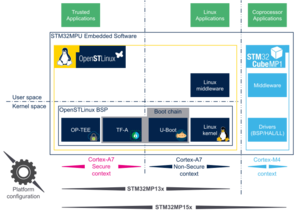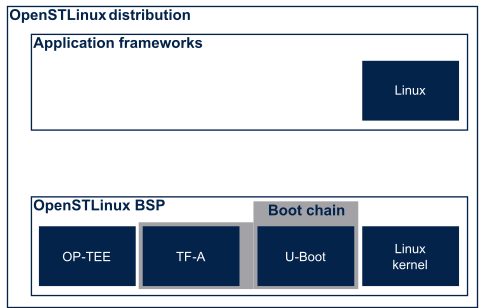Registered User mNo edit summary |
Registered User mNo edit summary |
||
| Line 1: | Line 1: | ||
<noinclude>{{ApplicableFor | |||
|MPUs list=STM32MP13x, STM32MP15x | |||
|MPUs checklist=STM32MP13x, STM32MP15x | |||
}}</noinclude> | |||
The '''OpenSTLinux distribution''' encompasses the following components: | The '''OpenSTLinux distribution''' encompasses the following components: | ||
* The '''OpenSTLinux BSP''' that offers services, to the application frameworks in the same context, from: | * The '''OpenSTLinux BSP''' that offers services, to the application frameworks in the same context, from: | ||
Revision as of 11:01, 22 June 2022
The OpenSTLinux distribution encompasses the following components:
- The OpenSTLinux BSP that offers services, to the application frameworks in the same context, from:
- The boot chain based on TF-A and U-Boot
- The OP-TEE secure OS running on the Cortex-A in secure mode
- The Linux® kernel running on the Arm® Cortex®-A in non-secure mode
- The Application frameworks that rely on the services provided by the OpenSTLinux BSP, to provide particular functionalities (code libraries, APIs, tool sets...) to facilitate the development of software applications:
- The Linux application frameworks (aka Linux middlewares) running on the user space of the Linux OS: e.g. libusb C library for a generic access to USB devices, ALSA user-space bundle for audio functionalities, GStreamer multimedia framework...
- The U-Boot application frameworks (not shown in the diagram), as part of the boot chain: e.g. configuration scripts
- On OP-TEE side, the Trusted Applications (TA) relies on the OP-TEE core for secrets operations (not visible from the Linux and STM32Cube MPU Package)
The figure below is clickable so that the user can directly jump to one of the sub-levels listed above.

